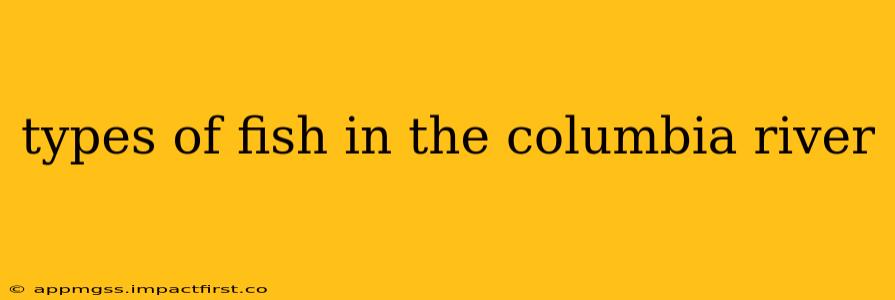The Columbia River, a behemoth of a waterway flowing from British Columbia to the Pacific Ocean, boasts an incredibly diverse ecosystem teeming with life. Its rich and varied habitats support a remarkable array of fish species, each playing a vital role in the river's complex web of life. Understanding the types of fish found in the Columbia River requires looking at different factors like water temperature, habitat type, and migration patterns. This exploration delves into the fascinating world of Columbia River fish, categorizing them and highlighting some of the most significant species.
What are the main types of fish in the Columbia River?
The Columbia River's fish population can be broadly categorized into several groups: anadromous fish, resident fish, and introduced species.
Anadromous Fish: These fish are born in freshwater, migrate to the ocean to mature, and then return to freshwater to spawn. This remarkable life cycle is crucial to the Columbia River ecosystem. Key examples include:
-
Salmon (Oncorhynchus spp.): The Columbia River is renowned for its salmon runs, with several species thriving in its waters. Chinook (King), Coho (Silver), Sockeye (Red), Pink, and Chum salmon all utilize the river for spawning, contributing significantly to the river's ecological and economic value. Their life cycle and population health are closely monitored due to their importance.
-
Steelhead (Oncorhynchus mykiss): These trout are another iconic anadromous species, exhibiting a similar life cycle to salmon. They are highly valued for both recreational fishing and their ecological significance.
Resident Fish: These fish spend their entire lives in freshwater, adapting to the river's diverse habitats. They play a crucial role in the food web and contribute to the overall biodiversity of the river. Some prominent examples include:
-
Rainbow Trout (Oncorhynchus mykiss): While some Rainbow Trout are anadromous (steelhead), many reside solely in freshwater throughout their lives. They inhabit various parts of the river, from fast-flowing streams to slower pools.
-
Smallmouth Bass (Micropterus dolomieu): A popular game fish, smallmouth bass are found in many parts of the Columbia River system.
-
White Sturgeon (Acipenser transmontanus): These ancient fish are a keystone species in the Columbia River, playing an essential role in maintaining the ecosystem's balance. Their long lifespan and large size make them a remarkable component of the river’s biodiversity.
Introduced Species: Some fish species have been introduced to the Columbia River, either intentionally or accidentally. These introductions can sometimes have significant impacts on the native fish populations and the overall ecosystem.
What is the most common fish in the Columbia River?
Determining the single "most common" fish is challenging due to variations in population numbers across different sections of the river and throughout the year. However, several species consistently demonstrate large populations. Rainbow trout and various salmon species, particularly Chinook salmon during peak migration, are often cited among the most abundant. The abundance fluctuates annually, affected by factors such as water flow, temperature, and prey availability.
What kind of fish are in the lower Columbia River?
The lower Columbia River, closer to the Pacific Ocean, experiences a mix of saltwater and freshwater influences. This brackish environment supports a unique assemblage of species, including many anadromous species during their migration. Expect to find high concentrations of various salmon species, particularly during their spawning runs, as well as steelhead. Resident species like sturgeon and various coastal fish species also thrive in this section of the river.
What fish are endangered in the Columbia River?
Several fish species in the Columbia River are considered endangered or threatened, primarily due to habitat loss, dam construction, overfishing, and the introduction of invasive species. Some of these species include certain salmon populations, particularly those dependent on specific spawning grounds impacted by damming. The white sturgeon, while not currently listed as endangered across its entire range, faces significant threats in certain areas of the Columbia River. Conservation efforts are ongoing to protect these vulnerable species and their habitats.
What is the biggest fish in the Columbia River?
The white sturgeon holds the title of the largest fish in the Columbia River. These behemoths can reach incredible sizes, with some individuals exceeding 10 feet in length and weighing over 1,000 pounds. Their impressive size and longevity make them a fascinating and important part of the river's ecosystem.
The Columbia River's fish populations represent a complex and dynamic ecosystem. Continuous monitoring, research, and conservation efforts are crucial to ensuring the long-term health and diversity of this remarkable aquatic environment. Further research into individual species will reveal even more about the intricacies of this crucial waterway.
